2020 MASERATI GRANTURISMO service
[x] Cancel search: servicePage 239 of 286
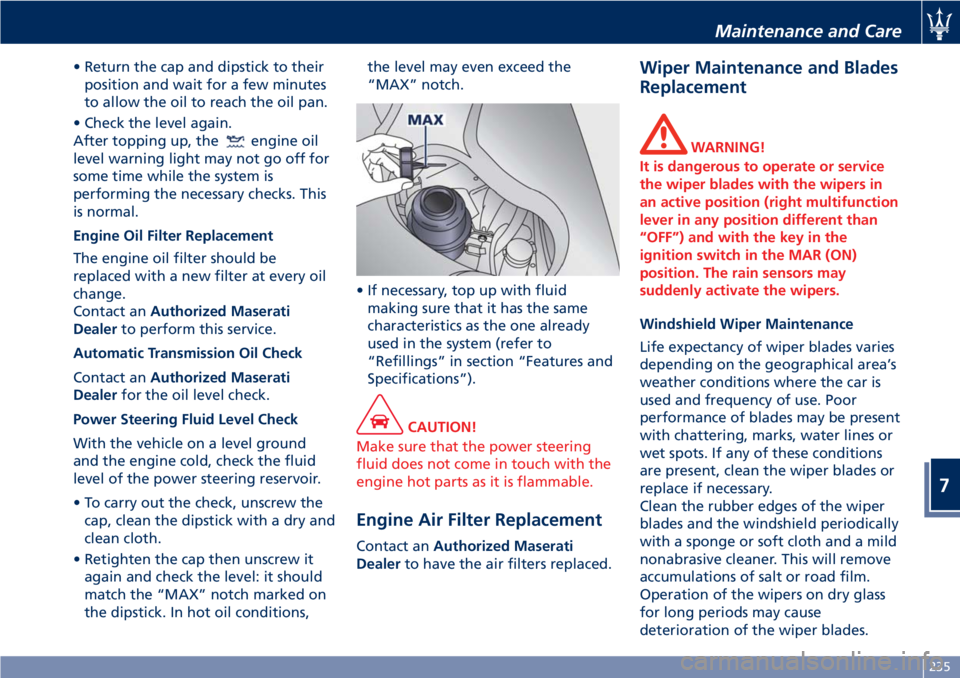
• Return the cap and dipstick to their
position and wait for a few minutes
to allow the oil to reach the oil pan.
• Check the level again.
After topping up, the
engine oil
level warning light may not go off for
some time while the system is
performing the necessary checks. This
is normal.
Engine Oil Filter Replacement
The engine oil filter should be
replaced with a new filter at every oil
change.
Contact anAuthorized Maserati
Dealerto perform this service.
Automatic Transmission Oil Check
Contact anAuthorized Maserati
Dealerfor the oil level check.
Power Steering Fluid Level Check
With the vehicle on a level ground
and the engine cold, check the fluid
level of the power steering reservoir.
• To carry out the check, unscrew the
cap, clean the dipstick with a dry and
clean cloth.
• Retighten the cap then unscrew it
again and check the level: it should
match the “MAX” notch marked on
the dipstick. In hot oil conditions,the level may even exceed the
“MAX” notch.
• If necessary, top up with fluid
making sure that it has the same
characteristics as the one already
used in the system (refer to
“Refillings” in section “Features and
Specifications”).
CAUTION!
Make sure that the power steering
fluid does not come in touch with the
engine hot parts as it is flammable.
Engine Air Filter Replacement
Contact anAuthorized Maserati
Dealerto have the air filters replaced.
Wiper Maintenance and Blades
Replacement
WARNING!
It is dangerous to operate or service
the wiper blades with the wipers in
an active position (right multifunction
lever in any position different than
“OFF”) and with the key in the
ignition switch in the MAR (ON)
position. The rain sensors may
suddenly activate the wipers.
Windshield Wiper Maintenance
Life expectancy of wiper blades varies
depending on the geographical area’s
weather conditions where the car is
used and frequency of use. Poor
performance of blades may be present
with chattering, marks, water lines or
wet spots. If any of these conditions
are present, clean the wiper blades or
replace if necessary.
Clean the rubber edges of the wiper
blades and the windshield periodically
with a sponge or soft cloth and a mild
nonabrasive cleaner. This will remove
accumulations of salt or road film.
Operation of the wipers on dry glass
for long periods may cause
deterioration of the wiper blades.
Maintenance and Care
7
235
Page 240 of 286

Always use washer fluid when using
the wipers to remove salt or dirt from
a dry windshield.
Avoid using the wiper blades to
remove frost or ice from the
windshield. Keep the blade rubber out
of contact with petroleum products
such as engine oil, gasoline, etc.
Spray nozzles
If the jet does not work, first check
that there is fluid in the pan (see
paragraph “Level checks” in this
section) then check that the nozzles
are not clogged.
Blades Replacement
• Move the right multifunction lever
into “OFF” position, (see chapter
“Windshield Wipers and Washers” in
section “Understanding the
Vehicle”).
• Lift the end of the arm provided with
the blade from the windshield.
• Rotate the blade on the arm in order
to access the release latch, shown in
the detail of picture.
• Press the release latch to free the
blade.
• Turn and slip off the blade from the
arm and replace it.• Return the blade to its original
position on the windshield.
NOTE:
Due to the difficulty of this operation,
we recommend that you contact an
Authorized Maserati Dealerfor
replacement of the blades.
Body Lubrication
Locks and all body pivot points,
including such items as seat tracks,
door hinge pivot points and rollers,
trunk lid and hood, sliding doors and
hood hinges, should be lubricated
periodically with a lithium based
grease, to assure quiet, easy operation
and to protect against rust and wear.
Prior to the application of any
lubricant, the parts concerned should
be wiped clean to remove dust and
grit; after lubricating excess oil andgrease should be removed. Particular
attention should also be given to hood
latching components to ensure proper
function. When performing other
underhood services, the hood latch,
release mechanism and safety catch
should be cleaned and lubricated. The
coupling pin of the lock on the rear
driver door pillar should be lubricated
twice a year, preferably in the Fall and
Spring. Apply a small amount of high
quality lubricant directly into the lock
cylinder.
Maintenance and Care
7
236
Page 241 of 286
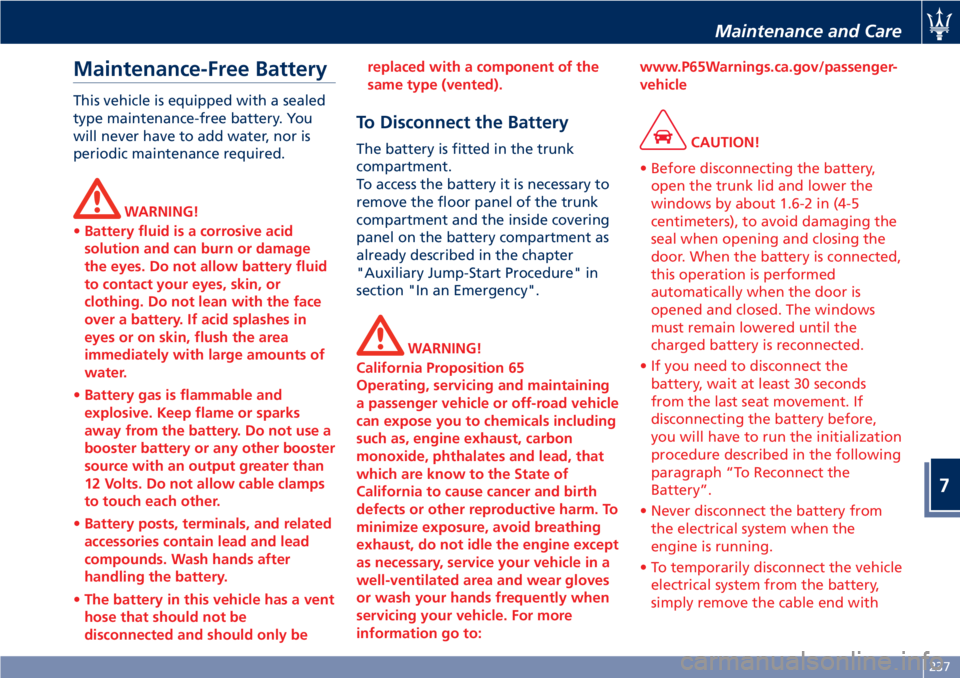
Maintenance-Free Battery
This vehicle is equipped with a sealed
type maintenance-free battery. You
will never have to add water, nor is
periodic maintenance required.
WARNING!
•Battery fluid is a corrosive acid
solution and can burn or damage
the eyes. Do not allow battery fluid
to contact your eyes, skin, or
clothing. Do not lean with the face
over a battery. If acid splashes in
eyes or on skin, flush the area
immediately with large amounts of
water.
•Battery gas is flammable and
explosive. Keep flame or sparks
away from the battery. Do not use a
booster battery or any other booster
source with an output greater than
12 Volts. Do not allow cable clamps
to touch each other.
•Battery posts, terminals, and related
accessories contain lead and lead
compounds. Wash hands after
handling the battery.
•The battery in this vehicle has a vent
hose that should not be
disconnected and should only bereplaced with a component of the
same type (vented).
To Disconnect the Battery
The battery is fitted in the trunk
compartment.
To access the battery it is necessary to
remove the floor panel of the trunk
compartment and the inside covering
panel on the battery compartment as
already described in the chapter
"Auxiliary Jump-Start Procedure" in
section "In an Emergency".
WARNING!
California Proposition 65
Operating, servicing and maintaining
a passenger vehicle or off-road vehicle
can expose you to chemicals including
such as, engine exhaust, carbon
monoxide, phthalates and lead, that
which are know to the State of
California to cause cancer and birth
defects or other reproductive harm. To
minimize exposure, avoid breathing
exhaust, do not idle the engine except
as necessary, service your vehicle in a
well-ventilated area and wear gloves
or wash your hands frequently when
servicing your vehicle. For more
information go to:www.P65Warnings.ca.gov/passenger-
vehicle
CAUTION!
• Before disconnecting the battery,
open the trunk lid and lower the
windows by about 1.6-2 in (4-5
centimeters), to avoid damaging the
seal when opening and closing the
door. When the battery is connected,
this operation is performed
automatically when the door is
opened and closed. The windows
must remain lowered until the
charged battery is reconnected.
• If you need to disconnect the
battery, wait at least 30 seconds
from the last seat movement. If
disconnecting the battery before,
you will have to run the initialization
procedure described in the following
paragraph “To Reconnect the
Battery”.
• Never disconnect the battery from
the electrical system when the
engine is running.
• To temporarily disconnect the vehicle
electrical system from the battery,
simply remove the cable end with
Maintenance and Care
7
237
Page 243 of 286
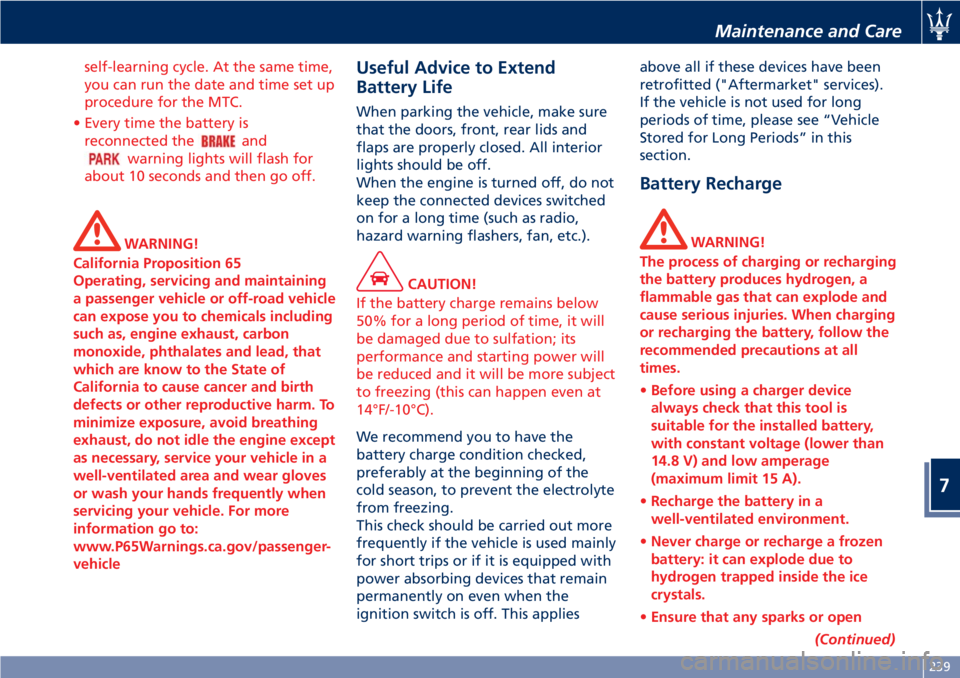
self-learning cycle. At the same time,
you can run the date and time set up
procedure for the MTC.
• Every time the battery is
reconnected the
and
warning lights will flash for
about 10 seconds and then go off.
WARNING!
California Proposition 65
Operating, servicing and maintaining
a passenger vehicle or off-road vehicle
can expose you to chemicals including
such as, engine exhaust, carbon
monoxide, phthalates and lead, that
which are know to the State of
California to cause cancer and birth
defects or other reproductive harm. To
minimize exposure, avoid breathing
exhaust, do not idle the engine except
as necessary, service your vehicle in a
well-ventilated area and wear gloves
or wash your hands frequently when
servicing your vehicle. For more
information go to:
www.P65Warnings.ca.gov/passenger-
vehicle
Useful Advice to Extend
Battery Life
When parking the vehicle, make sure
that the doors, front, rear lids and
flaps are properly closed. All interior
lights should be off.
When the engine is turned off, do not
keep the connected devices switched
on for a long time (such as radio,
hazard warning flashers, fan, etc.).
CAUTION!
If the battery charge remains below
50% for a long period of time, it will
be damaged due to sulfation; its
performance and starting power will
be reduced and it will be more subject
to freezing (this can happen even at
14°F/-10°C).
We recommend you to have the
battery charge condition checked,
preferably at the beginning of the
cold season, to prevent the electrolyte
from freezing.
This check should be carried out more
frequently if the vehicle is used mainly
for short trips or if it is equipped with
power absorbing devices that remain
permanently on even when the
ignition switch is off. This appliesabove all if these devices have been
retrofitted ("Aftermarket" services).
If the vehicle is not used for long
periods of time, please see “Vehicle
Stored for Long Periods” in this
section.
Battery Recharge
WARNING!
The process of charging or recharging
the battery produces hydrogen, a
flammable gas that can explode and
cause serious injuries. When charging
or recharging the battery, follow the
recommended precautions at all
times.
•Before using a charger device
always check that this tool is
suitable for the installed battery,
with constant voltage (lower than
14.8 V) and low amperage
(maximum limit 15 A).
•Recharge the battery in a
well-ventilated environment.
•Never charge or recharge a frozen
battery: it can explode due to
hydrogen trapped inside the ice
crystals.
•Ensure that any sparks or open
(Continued)
Maintenance and Care
7
239
Page 244 of 286

(Continued)
flames are kept well away from the
battery while it is charging.
•Before using a charger to charge or
maintain the battery charge status,
carefully follow the instructions
provided to ensure the charger is
connected to the battery safely and
correctly.
It is possible to recharge the battery
without disconnecting the cables of
the vehicle electrical system.
• To access the battery remove the
floor panel from the trunk
compartment and remove the inside
covering panel on the battery
compartment as previously shown
(see “Auxiliary Jump-Start
Procedure” in section “In an
Emergency”).
• Remove the protection cover and
connect the terminal clamp of the
charger positive cable (typically in
red) to the positive pole (+) of the
battery, indicated in the picture.
• Connect the terminal clamp of the
charger negative cable (typically in
black) to the negative pole (–) of the
battery, indicated in the picture.• Turn the charger on and follow the
instructions on its user manual to
completely recharge the battery.
• When the battery is recharged, turn
off the battery charger before
disconnecting it from the battery.
• Disconnect first the terminal clamp
of the charger black cable from the
battery and then the terminal clamp
of the red cable.
• Reassemble the protection cover on
the battery positive pole and reinstall
the components removed for this
operation.
WARNING!
California Proposition 65
Operating, servicing and maintaining
a passenger vehicle or off-road vehicle
can expose you to chemicals including
such as, engine exhaust, carbonmonoxide, phthalates and lead, that
which are know to the State of
California to cause cancer and birth
defects or other reproductive harm. To
minimize exposure, avoid breathing
exhaust, do not idle the engine except
as necessary, service your vehicle in a
well-ventilated area and wear gloves
or wash your hands frequently when
servicing your vehicle. For more
information go to:
www.P65Warnings.ca.gov/passenger-
vehicle
Maintenance and Care
7
240
Page 251 of 286
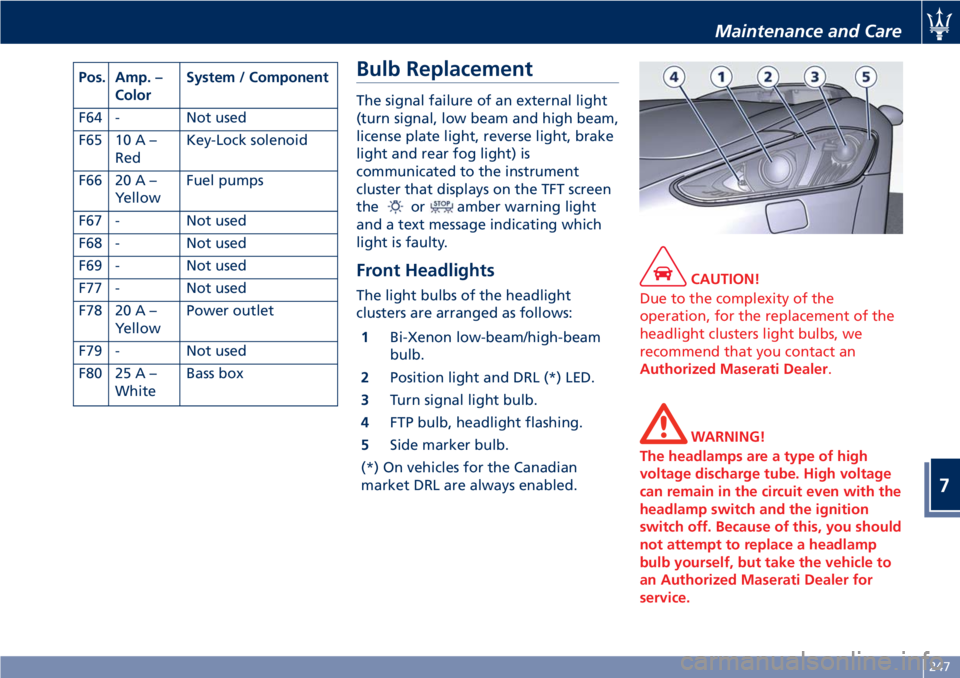
Pos. Amp. –
ColorSystem / Component
F64 - Not used
F65 10 A –
RedKey-Lock solenoid
F66 20 A –
YellowFuel pumps
F67 - Not used
F68 - Not used
F69 - Not used
F77 - Not used
F78 20 A –
YellowPower outlet
F79 - Not used
F80 25 A –
WhiteBass boxBulb Replacement
The signal failure of an external light
(turn signal, low beam and high beam,
license plate light, reverse light, brake
light and rear fog light) is
communicated to the instrument
cluster that displays on the TFT screen
the
oramber warning light
and a text message indicating which
light is faulty.
Front Headlights
The light bulbs of the headlight
clusters are arranged as follows:
1Bi-Xenon low-beam/high-beam
bulb.
2Position light and DRL (*) LED.
3Turn signal light bulb.
4FTP bulb, headlight flashing.
5Side marker bulb.
(*) On vehicles for the Canadian
market DRL are always enabled.
CAUTION!
Due to the complexity of the
operation, for the replacement of the
headlight clusters light bulbs, we
recommend that you contact an
Authorized Maserati Dealer.
WARNING!
The headlamps are a type of high
voltage discharge tube. High voltage
can remain in the circuit even with the
headlamp switch and the ignition
switch off. Because of this, you should
not attempt to replace a headlamp
bulb yourself, but take the vehicle to
an Authorized Maserati Dealer for
service.
Maintenance and Care
7
247
Page 256 of 286
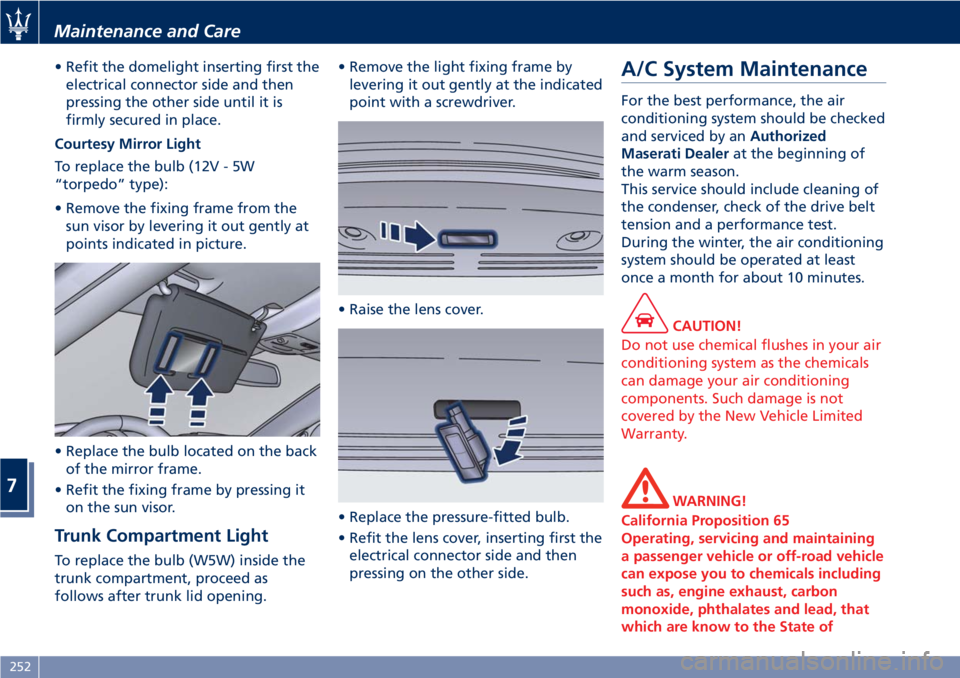
• Refit the domelight inserting first the
electrical connector side and then
pressing the other side until it is
firmly secured in place.
Courtesy Mirror Light
To replace the bulb (12V - 5W
“torpedo” type):
• Remove the fixing frame from the
sun visor by levering it out gently at
points indicated in picture.
• Replace the bulb located on the back
of the mirror frame.
• Refit the fixing frame by pressing it
on the sun visor.
Trunk Compartment Light
To replace the bulb (W5W) inside the
trunk compartment, proceed as
follows after trunk lid opening.• Remove the light fixing frame by
levering it out gently at the indicated
point with a screwdriver.
• Raise the lens cover.
• Replace the pressure-fitted bulb.
• Refit the lens cover, inserting first the
electrical connector side and then
pressing on the other side.
A/C System Maintenance
For the best performance, the air
conditioning system should be checked
and serviced by anAuthorized
Maserati Dealerat the beginning of
the warm season.
This service should include cleaning of
the condenser, check of the drive belt
tension and a performance test.
During the winter, the air conditioning
system should be operated at least
once a month for about 10 minutes.
CAUTION!
Do not use chemical flushes in your air
conditioning system as the chemicals
can damage your air conditioning
components. Such damage is not
covered by the New Vehicle Limited
Warranty.
WARNING!
California Proposition 65
Operating, servicing and maintaining
a passenger vehicle or off-road vehicle
can expose you to chemicals including
such as, engine exhaust, carbon
monoxide, phthalates and lead, that
which are know to the State of
Maintenance and Care
7
252
Page 257 of 286
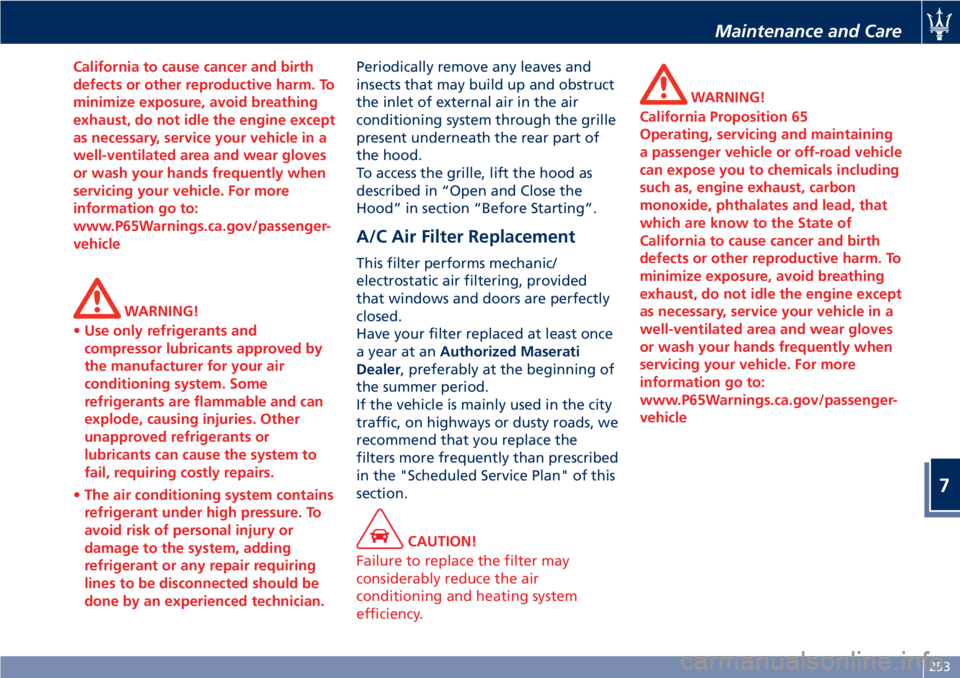
California to cause cancer and birth
defects or other reproductive harm. To
minimize exposure, avoid breathing
exhaust, do not idle the engine except
as necessary, service your vehicle in a
well-ventilated area and wear gloves
or wash your hands frequently when
servicing your vehicle. For more
information go to:
www.P65Warnings.ca.gov/passenger-
vehicle
WARNING!
•Use only refrigerants and
compressor lubricants approved by
the manufacturer for your air
conditioning system. Some
refrigerants are flammable and can
explode, causing injuries. Other
unapproved refrigerants or
lubricants can cause the system to
fail, requiring costly repairs.
•The air conditioning system contains
refrigerant under high pressure. To
avoid risk of personal injury or
damage to the system, adding
refrigerant or any repair requiring
lines to be disconnected should be
done by an experienced technician.
Periodically remove any leaves and
insects that may build up and obstruct
the inlet of external air in the air
conditioning system through the grille
present underneath the rear part of
the hood.
To access the grille, lift the hood as
described in “Open and Close the
Hood” in section “Before Starting”.
A/C Air Filter Replacement
This filter performs mechanic/
electrostatic air filtering, provided
that windows and doors are perfectly
closed.
Have your filter replaced at least once
a year at anAuthorized Maserati
Dealer, preferably at the beginning of
the summer period.
If the vehicle is mainly used in the city
traffic, on highways or dusty roads, we
recommend that you replace the
filters more frequently than prescribed
in the "Scheduled Service Plan" of this
section.
CAUTION!
Failure to replace the filter may
considerably reduce the air
conditioning and heating system
efficiency.
WARNING!
California Proposition 65
Operating, servicing and maintaining
a passenger vehicle or off-road vehicle
can expose you to chemicals including
such as, engine exhaust, carbon
monoxide, phthalates and lead, that
which are know to the State of
California to cause cancer and birth
defects or other reproductive harm. To
minimize exposure, avoid breathing
exhaust, do not idle the engine except
as necessary, service your vehicle in a
well-ventilated area and wear gloves
or wash your hands frequently when
servicing your vehicle. For more
information go to:
www.P65Warnings.ca.gov/passenger-
vehicle
Maintenance and Care
7
253